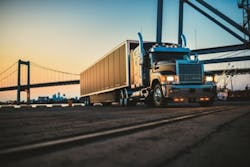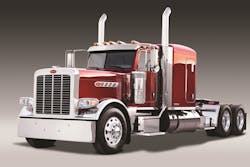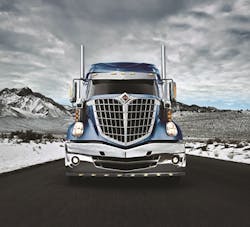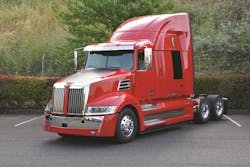Owner-operators are always going to play a big role in trucking—because they know how to adapt to changing times. The same goes for the trucks aimed at the independent trucker market. These new tractors are still the custom dream machines that turn heads and pamper the owner with all the amenities. But, more than ever, they’re being designed and built as tools of the trade—efficient and effective highway workhorses (that also can pass for show ponies in any parking lot).Western Star trucks are a classic example of classic style—and the brand’s limited production lends a certain swagger that a fleet truck with big market share can’t pull off. The readily identifiable red star badge on a long, square hood immediately conjures an image of hauling logs in the rugged Pacific Northwest or pulling a multi-trailer road train across the arid Outback.Add an industrial-strength grille guard to the massive nose, maybe even a row of off-road headlights, and some air horns on the cab, and you have one serious truck. But, explains Guy Lemieux, marketing segment manager for Western Star Trucks, customers now are asking for something a little different.“Our traditional trucks are great. People love them for heavy-haul and those kinds of applications,” Lemieux says. “But we did a lot of customer research, and we found that people really wanted to maintain that traditional look and styling and uniqueness, and they wanted aerodynamics—they wanted both.”What customers didn’t want was a truck that looked like a “jelly bean” or “minivan,” he notes. So the truck designers were “nudged” away from obvious shapes—and, in wind tunnel and road tests, it turned out that the hard edges work.Likewise, customers want to retain the sun visor and so, with a little work, the traditional touch proved aerodynamically neutral.The result is the new 5700XE, which cuts through the air about 9% better than Western Star’s current fuel efficiency highway tractor, the 4900FE set-back model.Lemieux concedes that Western Star is “the last to enter the fray” in the competition for fuel-efficient highway trucks, but he believes the 5700XE—which goes into full production in April—is a proven Western Star, yet lightweight and aerodynamic. And the market focus remains the same.“We don’t sell a thousand trucks at a time to these super-fleets,” Lemieux points out. “For smaller fleets that are image-conscious and for owner-operators, for sure, it’s a tried-and-true Western Star.”
Of course, Peterbilt is a brand that has long dominated the show-truck circuit, both in quality and quantity. A recent gathering of the faithful for a Peterbilt 75th anniversary event in Stockton, CA, drew nearly 400—that’s trucks, not visitors.But the iconic brand doesn’t plan to give up its place as a calendar pin-up and aspirational tractor to make the transition into 21st century trucking.“Peterbilt is a brand—built over many years and for reasons that maybe no one can understand—that resonates with the entire industry,” says Todd Acker, director of marketing. Yet the changing dynamics of the industry have not been lost on the truck maker. Acker notes that fleet consolidation, the rising price of equipment and operating costs—to say nothing of a recession or two—have made trucking a tough business for independents.‘Balancing act’“We don’t feel that owner-operators are out of the market, but their role has shifted,” he says, pointing to the many who have signed on with fleets for the bulk of their freight. “They’re purchasing equipment differently than they used to. And for us that’s been good.”The traditionally styled Model 389, for instance, “is as strong now as it’s ever been” in terms of production numbers, but Peterbilt has seen real growth in aerodynamic products.So how does a brand set itself apart in an era when truck makers have all adopted that scientifically effective shape and their trucks have begun to look like one another?Acker quickly points to three key areas:
- Fuel efficiency: Fuel expense is important to any truck operator, whether independent or fleet.
- Reliability: The requirement for uptime is “stronger than ever” for buyers, especially for an operator with one to five vehicles.
- Driver appeal: When truck drivers are in short supply and utilization is being hurt, having “the truck of choice”—built around comfort and ergonomics—is a key to success.
The Rawhide Edition takes customization even further. The package, installed on the axle-forward Pinnacle, comes with touches such as a “Texas bumper,” a big sun visor, 7-in. bullhorn exhaust stacks, chrome trim, and polished aluminum air and fuel tanks.“As an old-time Mack guy, since ’74, I’ve seen the transition and how our product has grown, and it amazes me to this day to get in that truck, the distinctive sound of closing the door,” Cary says. “Nothing could be more comfortable for a driver than to have everything wrapped around them—that nice interior, everything convenient to your fingertips.”International Truck has a corporate lineage that predates internal combustion engines, but the truck maker grabbed headlines and plenty of magazine covers when it introduced the LoneStar in 2009: a flat-out premium, owner-operator tractor that was ahead of its time.Both aerodynamic and undeniably distinctive, the LoneStar had the misfortune of coming out just as the Great Recession was kicking in—and as truck buyers ducked and waited for a recovery. But it’s a testament to International’s forward-thinking that the trucks are now more and more visible on the road, both in growing numbers and because of the still-distinctive looks.Navistar also continues to make its 9900 traditional model, and its best seller is the aerodynamic ProStar. The LoneStar was designed “to bridge the gap” between the two, explains Jodi Presswood, vice president and general manager of the heavy-duty truck product line for Navistar.The irony, as Presswood points out, is that the “new” front-end styling is borrowed directly from a 1930s International pickup truck.For the more budget-conscious operator, but one who still wants what he or she wants, the ProStar is available with several trim levels, including International’s long-lived Eagle “top-of-the-line” package featuring both interior and exterior touches.As with the other truck makers, International focuses on improving truck fuel efficiency as well as on reducing some costs that may not be the first thing an owner-operator considers when buying a new truck, such as serviceability and long-lasting components that keep the cost of ownership in check.Indeed, International is heavily promoting an uptime initiative “that will help the operator make money.”“We provide vehicles that appeal to the owner-operator because they’re attractive and customizable. We provide lots of choices so they can pick what they want,” says Presswood. “We’ve got great looking trucks.”Bells and whistles that payTop-end trim sets are attractive, but there are plenty of other choices on today’s trucks that are designed to benefit the bottom line.Among the most talked about, both by truck makers and by drivers at the truck stop diner, is the matter of automated transmissions: To shift or not to shift, that is the question.Manufacturers insist there’s little room for debate.While wind-tunnel tweaks are now focused on fractions of one percent improvement, the industry has made great strides in powertrain efficiency. The integration of engine, transmission, and axles is pushing Class 8 fuel economy to 10 mpg and beyond.And the sales pitch to fleets is straightforward: The new generation of automated transmissions can make your new drivers as good, fuel economy-wise, as your best veteran drivers.While that may not offend every successful owner-operator, it likely won’t sell them many trucks either. Still, truck makers insist there are advantages to letting technology do some of the work.The Western Star 5700XE, for instance, comes with a Detroit DD15 engine and optimized DT12 automated manual transmission.
Shifting Technologies“Less fatigue,” Western Star’s Lemieux says simply. “We know there are a lot of drivers out there who prefer a manual transmission. They want to be in control; they like the feel. But, especially in urban areas or stop-and-go traffic, an automated transmission really does reduce fatigue and improve comfort.”The good news is that truck buyers still have the option to deselect an AMT and go with the manual package of their choosing—and save significantly on the purchase price. Whether or not a driver is giving up fuel economy would depend on his or her skill in shifting manually.Likewise, truck and engine makers are now offering telematics systems that can monitor a truck while it’s on the road, detect and report problems, and even schedule maintenance. A single-truck operator may be reluctant to invest in a system that permits fleet dispatchers to immediately deal with delivery-threatening problems, but the consequences of a broken truck are all the more important to a fleet of one.Mack’s GuardDog Connect, for instance, is designed to proactively connect the truck operator “in real time with real people” to coordinate repairs—whatever is required to get that truck up and running again. “Downtime affects that single truck driver far more than it does a national fleet,” Cary says. “It can benefit everybody, but I think it’s actually more of an advantage to that owner-operator who can’t call for another truck to take the load.”Safety options such as roll stability, adaptive cruise control, and collision mitigation systems are more and more common, although pricey—until an operator calculates the costs of an accident. “A [key] piece moving forward is to make sure there’s a payback equation,” Navistar’s Presswood says. “The various industry associations really need to think about how we can get insurance companies to provide incentives for the purchase of these safety systems so that there is a less dramatic and more rational payback.”Who are these guys?Successful owner-operators—the kind who buy new, premium trucks—share some traits in common. Specifically, they know what has worked well for their own operations and they keep up with “the latest and greatest” in recent developments, Peterbilt’s Acker suggests.So it’s important for truck buyers to help dealers understand specific application and operational needs.“They need to maximize efficiency up front, but it’s very important for owner-operators to always consider what their trade cycle is going to be,” Acker says. “They want to be able to maximize the resale value of their equipment.”For Mack’s Cary, customers looking for premium trucks are typically single-truck operators or a fleet of maybe five trucks. He or she may do some specialized hauling, and has a good relationship with regular customers and brokers.“He’s never, never hauling empty,” Cary says. “He sets a high standard for himself. He sets high standards for the equipment he operates. His customers like to see him pull up in that type of vehicle: That’s an outward expression of who that driver is.”Simply, as long as there are owner-operators, there will be owner-operator trucks. The choice is still up to you, American trucker.
About the Author
Kevin Jones
Editor
Kevin has served as editor-in-chief of Trailer/Body Builders magazine since 2017—just the third editor in the magazine’s 60 years. He is also editorial director for Endeavor Business Media’s Commercial Vehicle group, which includes FleetOwner, Bulk Transporter, Refrigerated Transporter, American Trucker, and Fleet Maintenance magazines and websites.
Working from Beaufort, S.C., Kevin has covered trucking and manufacturing for nearly 20 years. His writing and commentary about the trucking industry and, previously, business and government, has been recognized with numerous state, regional, and national journalism awards.
Sign up for our eNewsletters
Get the latest news and updates




